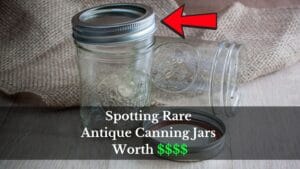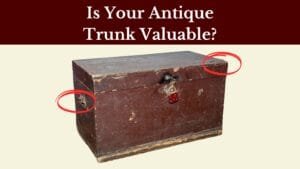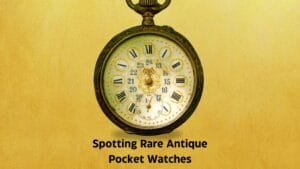Canning jars have always held a special place in our hearts, keeping our favorite food items safe and delicious. These charming relics evoke fond memories of family recipes passed down through generations. But what else makes them valuable?
Well, canning jars haven’t always been the way they are today; they once used wax seals and zinc screw tops as lids. And such old designs are quite rare and valuable! So, let’s explore highlighting features of antique canning jars & value them rightly!
Takeaways
- Pick the canning jars with visible pontil marks on their base, which tells that the jars were hand-blown, belonging to the early 1800s.
- Most vintage canning jars were made of clear, blue, or aqua-tinted glass. But you can look for rarer amber, olive green, purple, or red-tinted jars for a higher value.
- Pick jars with unique embossments like odd logos and designs to raise the old jar’s worth.
- Some rare canning jars are worth thousands of dollars today. Read on to find out more about those so you don’t miss the money!
Identification Features of Antique Canning Jars
It’s easy to confuse any old glass jar with a lid with a vintage canning jar if you don’t know the right antique features. So first of all, you must look for pontil marks on the jar’s base to confirm its handblown make.
Found it? Now look for the following features in your old jar:
- Glass with varying thicknesses and other signs of an old make like bubbles, fingerprints, stains, visible mold seams, etc.
- Embossed text, designs, patterns, or logos, as well as the patent dates, brand’s name, or jar type
- A zinc screw-on cap with rubber gaskets or a glass lid with wire bails
- Threaded jar neck for lid grip
- Transparent glass liners
- Scratches, chips, or staining from a long period of time and usage
Interesting History of Canning Jars
Although the first tin can was invented in 1810, the canning process for food preservation was developed by Nicolas Appert, a French chef, in the late 18th century. By the early 19th century, glass bottles and jars were being used for canning.
However, since these jars used wax or cork sealing, they were prone to spoilage. In 1958, John Landis Mason solved this problem by inventing the screw-threaded glass jar with a zinc lid that we know as Mason Jars. Handmade and safer, these jars fetch good returns even today!
In the next few years, the Mason Jar went under many variations. During the late 19th and early 20th century, different makers worked to make the jars more secure and accessible by making wide-mouth jars and airtight seals. Although newer, even these jars are in demand as they are now rare.
5 Main Types of Antique Canning Jars & Their Values
As we saw, different makers worked on different aspects of canning jars and came up with different types. Let’s explore all these types and their base values:
1. Cork or Wax Seal jars
These are one of the oldest canning jars that use cork or wax sealing to preserve edible items. But these jars didn’t offer a good seal to keep the food contamination-free, so they cost less, only around $5 – $15.
2. Screw-Top Mason Jars

These original Mason jars can be spotted by a milk-glass or transparent liner on the top of the mouth and their narrowed threaded necks. You would also see a threaded zinc screw-on cap, which gets screwed to the jar’s shoulder.
A common Mason jar costs around $10-$25, but if you find a rare shape, a patented model, or a rare colored jar, you can price it up to $50 – $120.
3. Lightning Jars

If you find an old glass bottle or jar with a glass lid secured with a metal wire bail, you’re looking at an old lightning jar invented around the 1870s. These jars offered a stronger airtight seal making them more popular and valuable, costing up to $20 – $60.
With unique embossing and glass tint, a vintage lightning jar can fetch up to depending on the size.
4. Atlas Jars or E-Z Seal Jars
Atlas jars were an improved version of lightning jars with a raised lip to prevent them from cracking. You can spot these with the “Atlas” logo, “E-Z Seal,” or “Strong Shoulder” embossments and price them around $10 – $40.
5. Kerr’s Self-Sealing Jars
As the name suggests, these jars have a special self-sealing closure thanks to their fixed rubber gasket that tightly holds the lid without screwing. You can also find wide-mouthed self-sealing Kerr jars, which can be priced around $30 – $100.
Identifying & Valuing Vintage Canning Jars with 7 Factors
After finding out the type of your vintage jar, let’s see what other factors affect its overall value:
1. Old Canning Jars Age

If you only want to get a vintage canning jar to add to your precious antique collection, get the most expensive and valued early or mid-19th-century jars. Even the early 1900s clear embossed jars can get you as much as $100-$300 on resale.
On the other hand, the later 20th-century jars may not be highly valued as they are newer. But how do you know which jar belongs to which era? Check out the deets below:
The Early 1800s Canning Jars:
You can easily spot the early 1800s canning jars or bottles with a cork or wax sealing system. Besides, there was no embossing on the jar. These jars today cost around $5 – 15$.
The Mid-1800s Canning Jars:
These canning jars can be identified by their threaded screwing closure using a glass liner and metal band. Glass jars with airtight seals also belong to this era. Also, you can see a wire bail airtight seal in the jars from this era, costing up to $100.
The Early 1900s Canning Jars:
If you spot wide-mouthed jars with embossed fruit motifs, designs, and logos or two-piece metal lids, it’s a newer mason jar from the late 1880s to the early 1900s era. These are also quite popular, costing around $20 – $120.
Below is a quick table to help you check the age and average prices of your items:
| Manufacturing Year | Age | Patent No. | Average Price for common small jars | Average Price of large, rare jars |
| 1850s | 160 – 175 years | US22186A (Mason’s Patent) | $15 – $75 | $50 – $200 |
| 1870s | 153 – 143 years | US137461A (Mason’s Patent for Fruit Jars | $20 – $80 | $90 – $500 |
| 1880s | 134 – 143 years | US256857A (Putnam’s Patent for Lightning Jars) | $10 – $50 | $75 – $400 |
| 1900s – 1910s | 113 – 123 years | US1152107A (Kerr’s Patent for Self-Sealing Jars) | $7 – $40 | $30 – 100 |
Pay attention to the jar embossment; you can date your antique Ball jars by identifying the font style of the embossed logo.
2. Jar Colors

Most of the early canning jars came in transparent, aqua, or dark blue color. But if you want to make good money, look for unique amber, red, purple, or black jars. And if you find a rare two-tone glass jar, you can price it up to $200.
Check out this average valuation of canning jars of different colors:
| Antique Canning Jar Colors | Estimated Price |
| Clear Glass or Transparent | $10 – $40 |
| Aqua or Light Blue | $10 – $80 |
| Cobalt Blue | $15 – $100 |
| Amber or Bright Yellow | $20 – $160 |
| Light Green | $15 – $80 |
| Purple | $20 – $170 |
| Dark/Light Olive Green | $150 – $300 |
3. Jar Brands
The brand is another vital factor affecting an old canning jar’s resale value. Among the popular canning jar brands, Ball mason jars are quite popular and fetch good returns. For limited edition jars, you can look for Drey and Presto jars.
Let’s check out how the price changes with the brands:
| Brand Name | Embossments | Average Value for Common Jars | Average Value for Rare Jars |
| Mason | Mason Jar | $10 – $80 | Up to $500 |
| Ball Jars | Ball Mason Jar, Perfect Mason Jar | $5 – $50 | Up to $350 |
| Kerr Jars | Self-Sealing Jar, Economy Jar | $5 – $60 | Up to $130 |
| Hazel-Atlas Jars | E-Z Seal Jar, Strong Shoulder Jar | $10 – $40 | Up to $170 |
| Dreys Jars | Drey Perfect Mason Jar & Drey Improved Ever Seal | $15 – 70 | Up to $100 |
| Presto Jars | Presto Jar | $5 – $40 | Up to $80 |
4. Rarity of Canning Jar Models

Of course, the value of old canning jars varies as per their size, color, and brand, but a really unique jar having limited pieces around the world can be worth thousands!
If you come across a really rare jar with unique features, like unique color, embossments, or closure style, or a different pattern, you can fetch up to $500 – $1,000 for one jar. That’s right!
Below are mentioned some of the rare canning jars and their estimated prices:
| Rare Canning Jars | Feature | Average Value |
| Ball’s Upside-Down Jar (the 1930s) | The Ball logo embossed upside-down | Up to $1,000 |
| Willoughby Stopple Jars (1858) | Unique cork lid, error design | $300 – $500 |
| Canadian Beaver Jar (1860) | “The Beaver Jar” embossment | $200 – $350 |
| Black Amber Magic Star Fruit Jar (1886) | Opaque black amber bottle with “The Magic Fruit Jar” embossment | $1,000 – $3,000 |
| Van Vliet Improved jar (1881) | A wire bail across the height of the jar for sealing | $1,000 – $$23,000 |
5. Embossments & Marks

Embossing can also greatly affect the value of an antique canning jar. Besides, the font style of text embossment can also help you track the jar’s age, especially Ball jars.
For instance, if your jar has a unique embossed BBGMC logo, it’s a Ball jar from 1880-1890. But if it has a cursive Ball logo with two Ls, it’s an early 1900s jar, costing up to $80.
To increase the resale value, look for jars with unique logos, patterns, or design embossings, such as fruit (Fruit Jar), lady (Willoughby Stopple Jar), etc. A jar with a misspelled brand name can also fetch good returns.
6. Jar’s Condition
An old canning jar will definitely have some hand-made features, like pontil spots, bubbles, and even mold seams. But if it contains many chips, dents, and cracks, it will greatly reduce its monetary value.
So, to make your old jar worth its value, make sure it is in good shape. Look for blemishes and dents and price it accordingly.
7. Closure Types
The oldest closure techniques, like the wax and cork seal, might not have been the best canning process back in the 1800s, but since they’re rare today, they attract collectors. The milk-glass liner and rubber gasket sealing also make the jars valuable.
Similarly, jars with screw-on zinc lids and wire bail seals are also very old and, hence, valued more than the latter late 20th-century jars.
How can you tell if a Mason jar is valuable?
A mason jar or canning jar is older and more valuable if it has older, simpler logos or brand name embossments. You can also look for signs of an old make, such as pontil marks, mold seams, bubbles, uneven glass thickness, etc., to make sure it’s a real vintage jar.
What does the number on the bottom of a Mason jar mean?
The number at the jar’s bottom is usually the mold number, the number assigned to the mold in which the jar was made. The number doesn’t indicate the manufacturing year and will not help track the jar’s age.
What colors are vintage mason jars?
The oldest mason or canning jars were made of clear or aqua or light blue glass; the tint came from the sand from around Lake Michigan, using which the glass was made. But even the rare colors like olive green, amber, bright yellow, purple belong to the mid-1800s – early 1900s era.
So, if you have old jars in your grandma’s cupboard, clean them and check for the important details, logos, and embossments. You may end up holding a vintage canning jar worth hundreds of dollars. And if you’d like to learn about identifying antique drinking glasses and glass decanters, join us now!
Note: This article is intended for informational, educational, and entertainment purposes only. Some images are illustrative and may not represent actual brands, products, or related entities. All trademarks, product names, brand logos, packaging, and other intellectual property referenced remain the exclusive property of their respective owners. Any brand mentions or references are provided solely for descriptive and educational context and do not imply any formal or commercial association.










